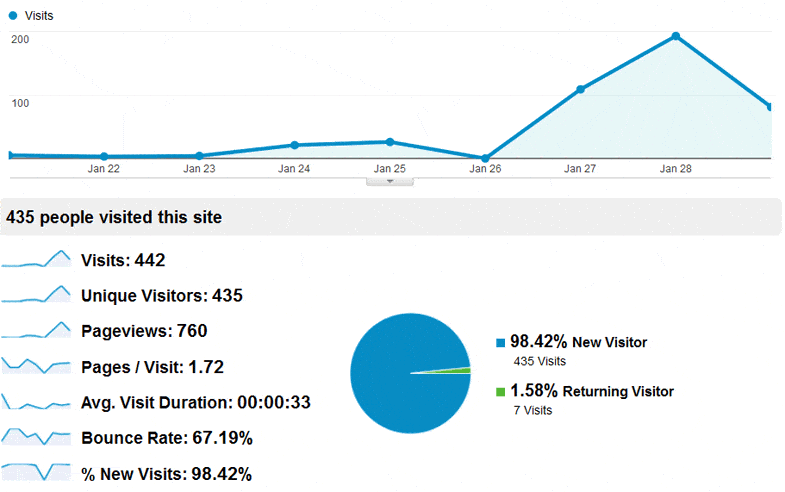Once you have put in all the effort of creating your beautiful new website, it’s time to submit your website to search engines. There’s an old saying “build it and they will come”. Well, this does not apply to the Internet. Not at all!
The importance of submitting your website to search engines cannot be overstated and there are many reasons why you’d want to do this quickly, but before you jump ahead, make sure you can answer “yes” to the following:
- Is your website finished, or at least 90% there?
- Does your website look professional enough to be considered respectable to new visitors?
- Have you included a privacy policy within the contents of your website?
- Do you have at least 5 pages of content or blog posts?
- Do you have a sitemap of your website (a list of all page links)?
If you answered “no” to any of the above questions, rectify the problem immediately.
You may have been thrown a curve-ball by the privacy policy question. While this is not 100% essential for all types of websites, for most it is. Google wants to see that you care about your website visitor’s privacy, especially if you are collecting information for an e-commerce store, email subscriptions, have contact forms on your website or collect any other visitor data.
Without the privacy policy, indexing your website could be delayed by Google while they wait for other signals pertaining to your respectability.
Are You Ready To Submit Your Website To Search Engines?
Don’t expect results overnight, let me be clear right from the start. This may be a shocker but it may take up to 3 months for your website to be listed in any meaningful way after submitting it to the search engines.
Google and other search engines wait for other signals to determine whether your website is respectable enough to get a good ranking.
I’m only going to talk about two search engines and one directory, and you won’t need to submit your website to any others. Why?
Well, for the most part, these 3 cover 95%+ of all search traffic you’re likely to receive to your website. Also, because over time those other 5% will index your website without any intervention on your part.
Create A Sitemap
“What is a sitemap and why should I care?”, I hear you ask. A sitemap is simply a list of all the pages of your website. If you don’t have a WordPress website, you can create a sitemap manually using a text editor.
A simple sitemap just includes one link per line in a plain text file, for example:
http://www.mydomain.com/index.html
http://www.mydomain.com/page1.html
http://www.mydomain.com/page2.html
http://www.mydomain.com/contact.html
http://www.mydomain.com/privacy.html
You can name the file anything, let’s say sitemap.txt. Upload this file to your web hosting, sitting together with all other files in the main folder so that it can be accessed at http://www.mydomain.com/sitemap.txt
If your website is running on a CMS like Joomla or WordPress, a sitemap is already created for you automatically in XML format. You can find a WordPress sitemap, depending on your plugins, at http://www.mydomain.com/sitemap.xml or http://www.mydomain.com/sitemap_index.xml
So, that’s sitemaps. They’re important. Keep them up-to-date.
Now, let’s get to the fun bit so we’ll start with the obvious…
Add Your URL To Google
Submit your website to Google here
Pretty simple, right? Well, there’s something else you should do before ticking off ‘submitted to Google’.
Get yourself signed up for Google Webmaster Tools, add your website and verify it using the methods described.
Once your website is fully setup in Webmaster Tools, your domain should be listed on the Home page. Click on the domain to manage it, then click on the Optimization section.
Click on Sitemaps and then Add/Test Sitemap. Enter the full address of your sitemap and click Submit
You only need to do this once and Google will frequently check your sitemap for any updates automatically. This ensures all your website’s pages are included in Google’s index.
Google Webmaster Tools is great for checking your website’s performance in Google, providing different statistics than Google Analytics, so I recommend checking in there often.
Add Your URL To Bing
Submit your website to Bing here
Pretty simple, right? Well, just the same as what we did for Google, we’ll need to do for Bing, Microsoft’s search engine that powers Yahoo and Facebook search.
Go ahead and sign up for Bing Webmaster Tools
You will find a similar interface to Google’s Webmaster Tools.
Once you have added your website and verified it, your domain should be listed on the Home page. Click on the domain to manage it, then click on Configure My Site
Click on Sitemaps and then enter the full address of your sitemap and click Submit
Same as Google, you only need to do this once because Bing will frequently check your sitemap for any updates automatically.
Bing Webmaster Tools also has some interesting statistics to give you an idea about your website’s performance, so check in regularly.
But don’t just stop with Google and Bing…
DMOZ Open Directory Project
D-whats? Never heard of DMOZ? It’s a directory curated by humans where your submission is checked by a real-life, breathing human-being before being added to the directory.
DMOZ garners an enormous amount of respect and authority from Google and other search engines.
All search engines scan DMOZ for new additions to the directory and will add those websites to it’s own index.
Getting your website listed in DMOZ is a big deal. It’s also quite difficult.
I highly recommend reading How To Get A DMOZ Listing For Some Google SEO Love
Posts related to How To Submit Your Website To Search Engines Without The Hassle
Image Search Causes Huge Upswing In Website Traffic How To Get A DMOZ Listing For Some Google SEO Love
How To Get A DMOZ Listing For Some Google SEO Love 8 Google SEO Mistakes That Will Choke Your Search Ranking
8 Google SEO Mistakes That Will Choke Your Search Ranking How To Change Domain Name Without Impacting SEO
How To Change Domain Name Without Impacting SEO
Tags: submit to bingsubmit to googlesubmit your websitesubmit your website to search engines





